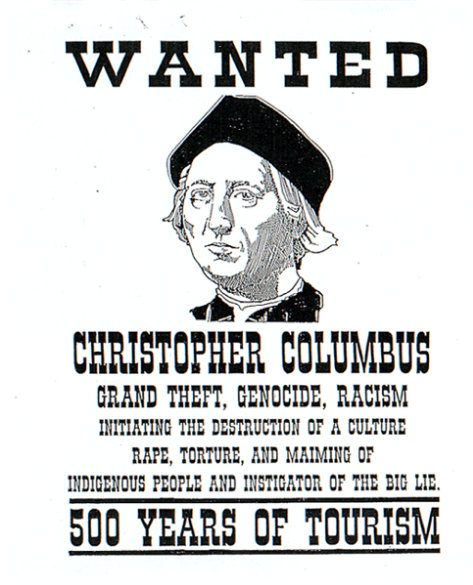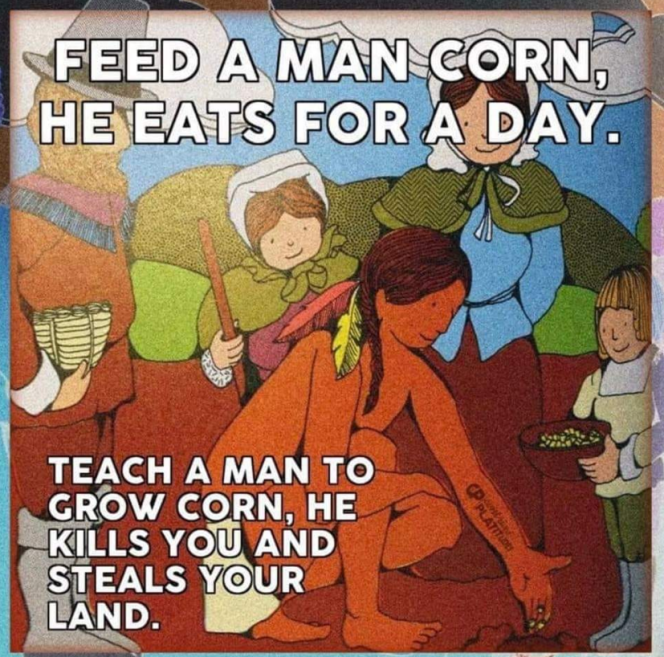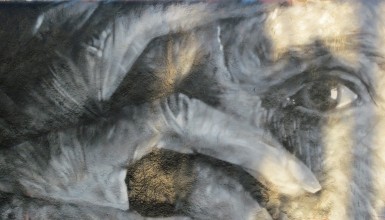Kristeen Irigoyen-Hernandez aka Lady2Soothe Follow @OurVoicesEcho


One cannot ‘discover’ what was never lost in the first place! Unlike Christopher Columbus, Native people always knew where they were, right here on Turtle Island. It has been estimated there were upwards of 100 million Indigenous people living here at the time of the Europeans who found hundreds of different culturally, richly textures settled peoples scatters all across the land, most with very complex and sophisticated matriarchal social/political organizations and belief systems. Voyagers finally showed up, their names were the one extolled in your White history books, not the names of First Nations people who got the Europeans where they wanted to go!
Columbus quite literally landed in what is now known as the Bahamas and later Hispaniola, present-day Haiti and the Dominican Republic. So why do American’s celebrate this abominable man? Let’s just ignore the fact millions of humans already inhabited this land until later and look at the historical facts.
In the first place, Columbus was not the first European explorer to reach the Americas having been preceded by the Norse expedition led by Leif Ericson; however, Columbus’ voyages led to the first lasting of European contact with America, inaugurating a period of European exploration and colonization of foreign lands until present-day. Therefore Columbus has had an enormous impact on the historical development of the modern Western world.
Forget those myths perpetuated about Columbus attempting to prove the earth is round because he got the math wrong and actually thought the earth was pear-shaped. He saw his accomplishments primarily in the light of the spreading of the Christian religion and finding gold to repay his debt to the crown.
The Nina and Pinta were not the names of two of Columbus’ three ships. In 15th-century Spain, ships were traditionally named after saints. Salty sailors, however, bestowed less-than-sacred nicknames upon their vessels. Mariners dubbed one of the three ships the Pinta, Spanish for “the painted one” or “prostitute.” The Santa Clara was nicknamed the Nina in honor of its owner, Juan Nino. Although Santa Maria is called by its official name, its nickname was La Gallega, after the province of Galicia in which it was built.
In 1493 when Columbus arrived in Haiti, the Dominican Republic, and the Caribbean islands, there were eight million Indigenous Taino residents. That number, within a mere three years, was reduced to just three million.
Upon arrival, Columbus and his expedition met the Arawaks, Tainos and Lucayans, all friendly *Indians*, according to Columbus’ writings. When Columbus first saw the Native Arawaks who came to greet him and his crew he spoke with a peaceful and admiring tone. Impressed with the friendliness of the native people, Columbus seized control of the land in the name of Spain.
Columbus also helped himself to some locals. In his journal he wrote:
“As soon as I arrived in the Indies, on the first Island which I found, I took some of the natives by force in order that they might learn and might give me information of whatever there is in these parts. They … brought us parrots and balls of cotton and spears and many other things… They willingly traded everything they owned… They were well-built, with good bodies and handsome features…. They do not bear arms, and do not know them, for I showed them a sword, they took it by the edge and cut themselves out of ignorance. They have no iron. Their spears are made of cane. They would make fine servants…. With fifty men we could subjugate them all and make them do whatever we want.”
After several months in the Caribbean, on January 13, 1493, two Natives were murdered during trading. Columbus, who had described the Natives as gentle people wrote “(they are) evil and I believe they are from the island of Caribe, and that they eat men.” He also described them as “savage cannibals, with dog-like noses that drink the blood of their victims.”
Columbus introduced syphilis to Europe when he sold Native sex slaves to his men. Columbus wrote to a friend in 1500, “girls from 9-10 … are … in demand.” After Columbus’s first trip to the Caribbean, he returned to Spain and left behind 39 men who went ahead and helped themselves to Native women. Upon his return, the men were all dead.
With 1,200 more soldiers at his disposal, rape and pillaging became rampant as well as tolerated by Columbus. This is supported by a reported close friend of Columbus, Michele de Cuneo who wrote the first disturbing account of a relationship between himself and a Native female gifted to him by Columbus. Cuneo, wrote
“When our caravels … were to leave for Spain, we gathered … 1,600 male and female Indians and these embarked (with us) … on February 17, 1495 he wrote “While I was in the boat I captured a very beautiful Carib woman, whom the said Lord Admiral gave to me, and with whom, having taken her into my cabin, she being naked according to their custom, I conceived desire to take pleasure. I wanted to put my desire into execution but she did not want it and treated me with her fingernails in such a manner that I wished I had never begun. But seeing that (to tell you the end of it all), I took a rope and thrashed her well, for which she raised such unheard-of screams that you would not have believed your ears. Finally, we came to an agreement in such manner that I can tell you that she seemed to have been brought up in a school of harlots.”
Repeated accounts of cruelty and murder included testing the sharpness of blades on Native people by cutting them in half, beheading them in contests and throwing them into vats of boiling soap. Many of these red men, women, and children were
“roasted on spits,”
and the invaders
“hacked the children into pieces.”
Spanish historian and Catholic priest Bartolome de las Casas witnessed much of the carnage and said Columbus ordered his men
“ to cut off the legs of children who ran from them in order to test the sharpness of their blades.” and “Such inhumanities and barbarisms were committed in my sight as no age can parallel. My eyes have seen these acts so foreign to human nature that now I tremble as I write.”
Columbus’s men would make bets as to who would slit a man in two, or cut off his head in one blow. There are also accounts of suckling infants being lifted from their mother’s breasts, only to be dashed headfirst into large rocks. There was also a practice known as the “Montería Infernal”, the infernal chase, or manhunt, in which Natives were hunted by war-dogs. These dogs wore armor and had been fed human flesh, were a fierce match for the Indians. If his crew began running out of meat for their vicious dogs,
“Arawak babies were killed for dog food.”
Live babies were also fed to these war dogs as sport, sometimes in front of horrified parents.
Spaniards removed men from villages to work in gold mines and colonial plantations. This kept the Taíno from planting the crops which had fed them for centuries. They began to starve; many thousands fell prey to smallpox, measles and other European diseases for which they had no immunity; some committed suicide to avoid subjugation; hundreds fell in fighting with the Spaniards, while untold numbers fled to remote regions beyond colonial control. And on his return to Europe Columbus brought back the first Indigenous people as slaves all but wiping out the people to the Caribbean, leaving very few Indigenous Natives after 50 years; as many as three million people, approximately 85 percent of the Taíno population had vanished by the early 1500s
By Columbus’ second voyage to the New World in 1495, he brought cannons and attack dogs. If a native resisted slavery, he would cut off a nose or an ear. If slaves tried to escape, Columbus had them burned alive. Other times, he sent attack dogs to hunt them down, and the dogs would tear off the arms and legs of the screaming natives while they were still alive. He was so desperate for gold to repay the Spanish bankers which financed him Columbus refused to believe there was almost no gold on the island so he forced Natives to work in gold mines until exhaustion. Those who opposed were beheaded or had their ears cut off and he forced the island’s Taino inhabitants to bring him a ‘hawk’s bell’ full of gold dust every three months. Those who complied were given a ‘token’ to wear around their necks. Those who didn’t, as Columbus’s son Fernando reported, were
“punished by having their hands cut off” and were “left to bleed to death.”
In two years’ time, approximately 250,000 Indians on Haiti were dead.
In August 1504 Colonists complained to Governor Francisco De Bobadilla of the monarchy about mismanagement and a royal commissioner was dispatched to Hispaniola to arrest Columbus and his two brothers, slapped them into chains, and shipped them off to Spain to answer for their crimes against the Arawaks. But the King and Queen of Spain, their treasury filling up with gold, pardoned Columbus and let him go free, but by then only about 100,000 Taino’s remained alive.
Columbus derived most of his income from slavery, De Las Casas noted. In fact, Columbus was the first slave trader in the Americas. As the native slaves died off, they were replaced with black slaves. Columbus’ son became the first African slave trader in 1505.
Tens of thousands of Indigenous people were killed because they would not convert to a religion completely foreign to them, one of which they understood neither the content nor the language being spoken to them. Columbus was a tyrant, a murderer and nothing short of a pimp and pedophile, he didn’t discover, he invaded, destroyed and annihilated. Columbus didn’t just marginalize Indigenous people he mutilated and nearly decimated them because in his eyes 1st Nation Indigenous peoples of the Americas stood in the way of European ‘progress’ hampering western expansion. What followed was rape, murder, destruction and all forms of genocide, land, resource destruction and theft.
The portrayal of the man with 3 ships who came to befriend the Natives is an utter fallacy. The Whitewashed White romantic myth is a complete falsehood because one cannot ‘discover’ what was never lost in the first place! Unlike Christopher Columbus, 1st Nation Native people always knew where they were, right here on Turtle Island.
It has been estimated there were upwards of 100 million Indigenous people living in the area we call America’s. At the time of the Europeans found hundreds of different culturally, richly textures settled people’s scatters all across the land, most with very complex and sophisticated matriarchal social/political organizations and belief systems. Voyagers showed up, their names are the ones extolled in your White history books, not the names of First Nations people who got the Europeans where they wanted to go!
Winona LaDuke ~ Columbus was a perpetrator of genocide. He was a slave trader, a thief, a pirate and most certainly NOT a hero. To celebrate Columbus is to congratulate the process and the history of invasion.



Kristeen Irigoyen-Hernandez
Human Rights Advocate, Researcher/Chronological Archivist and member in good standing with the Constitution First Amendment Press Association (CFAPA.org)
Kristeen Irigoyen-Hernandez aka Lady2Soothe Follow @OurVoicesEcho


